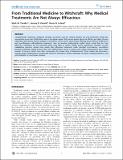Files in this item
From traditional medicine to witchcraft : why medical treatments are not always efficacious
Item metadata
| dc.contributor.author | Tanaka, M M | |
| dc.contributor.author | Kendal, J R | |
| dc.contributor.author | Laland, Kevin Neville | |
| dc.date.accessioned | 2013-11-29T17:01:01Z | |
| dc.date.available | 2013-11-29T17:01:01Z | |
| dc.date.issued | 2009-04 | |
| dc.identifier | 450221 | |
| dc.identifier | 26c7ff6a-555f-44ce-91c5-e7dcc0f7cf28 | |
| dc.identifier | 65349166686 | |
| dc.identifier.citation | Tanaka , M M , Kendal , J R & Laland , K N 2009 , ' From traditional medicine to witchcraft : why medical treatments are not always efficacious ' , PLoS ONE , vol. 4 , no. 3 , e5192 . https://doi.org/10.1371/journal.pone.0005192 | en |
| dc.identifier.issn | 1932-6203 | |
| dc.identifier.other | standrews_research_output: 30531 | |
| dc.identifier.other | ORCID: /0000-0002-2457-0900/work/60630346 | |
| dc.identifier.uri | https://hdl.handle.net/10023/4227 | |
| dc.description | The work was supported by the Research Councils UK, Biotechnology and Biological Sciences Research Council UK and the European Union. The funders had no role in study design, data collection and analysis, decision to publish, or preparation of the manuscript. | en |
| dc.description.abstract | Complementary medicines, traditional remedies and home cures for medical ailments are used extensively world-wide, representing more than US$60 billion sales in the global market. With serious doubts about the efficacy and safety of many treatments, the industry remains steeped in controversy. Little is known about factors affecting the prevalence of efficacious and non-efficacious self-medicative treatments. Here we develop mathematical models which reveal that the most efficacious treatments are not necessarily those most likely to spread. Indeed, purely superstitious remedies, or even maladaptive practices, spread more readily than efficacious treatments under specified circumstances. Low-efficacy practices sometimes spread because their very ineffectiveness results in longer, more salient demonstration and a larger number of converts, which more than compensates for greater rates of abandonment. These models also illuminate a broader range of phenomena, including the spread of innovations, medical treatment of animals, foraging behaviour, and self-medication in non-human primates. | |
| dc.format.extent | 508396 | |
| dc.language.iso | eng | |
| dc.relation.ispartof | PLoS ONE | en |
| dc.subject | Complemetary medicine | en |
| dc.subject | Alternative medicine | en |
| dc.subject | Non-efficacious self-medicative treatment | en |
| dc.subject | Mathematical modeling | en |
| dc.subject | Cultural evolution modeling | en |
| dc.subject | RZ Other systems of medicine | en |
| dc.subject | SDG 3 - Good Health and Well-being | en |
| dc.subject.lcc | RZ | en |
| dc.title | From traditional medicine to witchcraft : why medical treatments are not always efficacious | en |
| dc.type | Journal article | en |
| dc.contributor.institution | University of St Andrews. School of Biology | en |
| dc.contributor.institution | University of St Andrews. Scottish Oceans Institute | en |
| dc.identifier.doi | https://doi.org/10.1371/journal.pone.0005192 | |
| dc.description.status | Peer reviewed | en |
| dc.identifier.url | http://www.scopus.com/inward/record.url?scp=65349166686&partnerID=8YFLogxK | en |
This item appears in the following Collection(s)
Items in the St Andrews Research Repository are protected by copyright, with all rights reserved, unless otherwise indicated.

